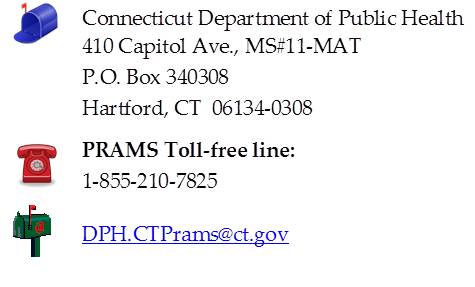
Connecticut PRAMS, the Pregnancy Risk Assessment Monitoring System, is a surveillance project of the Connecticut Department of Public Health and the federal Centers for Disease Control and Prevention (CDC). PRAMS collects information on maternal attitudes and experiences before, during, and shortly after pregnancy from a sample of postpartum women in Connecticut. Information from PRAMS will be used to help plan better health programs for Connecticut mothers and infants.
The goal of the PRAMS project is to improve the health of mothers and infants by reducing adverse outcomes such as low birth weight, infant mortality and morbidity, and maternal morbidity. PRAMS provides state-specific data for planning and assessing health programs and for describing maternal experiences that may contribute to maternal and infant death.
 Women who participate in PRAMS are making a real difference.
Women who participate in PRAMS are making a real difference.
Women who complete the PRAMS survey help not only themselves, but other women and babies as well.
Every pregnancy is different. To get a better overall picture of the health of mothers and babies in Connecticut, we need each mother selected to answer the questions. We need to know what went right as well as what went wrong during your pregnancy. Information from PRAMS helps the Department of Public Health improve existing programs and helps inform new ones to better meet the needs of Connecticut’s mothers and babies. What we learn through PRAMS can also help doctors, nurses, and health organizations improve health care services and policies. Your help is really important to the success of our program. However, participation is voluntary and you may choose not to answer certain questions on the survey.
If you receive a PRAMS survey, please consider making a difference – please complete it!
For Frequently Asked Questions - Click Here
For Additional Resources - Click Here
Forty-seven states, New York City, Puerto Rico, the District of Columbia and the Great Plains Tribal Chairmen’s Health Board (GPTCHB) currently participate in PRAMS, representing approximately 83% of all U.S. live births.
We invite you to explore the CDC PRAMS website and those of other PRAMS states to see the wonderful things that have been accomplished.

Each month, birth certificate information is used to generate a list of Connecticut women who have delivered a live born infant instate within the past two to six months. From this list, approximately 200 women per month are randomly selected to participate in the survey.
Addressing racial and ethnic disparities is an overarching priority for programs within the Connecticut DPH. Staff within DPH’s Community, Family Health and Prevention Section (CFHPS) are actively working to both understand and address the marked and persistent perinatal disparities that exist for particular racial and ethnic groups in Connecticut. As such, ensuring there is an adequate number of responses from affected racial and ethnic groups of interest are critical for analysis.
Women from certain racial and ethnic groups are sampled at a higher rate because some groups experience more pregnancy-related problems. Oversampling ensures that an adequate number of responses are attained to allow for meaningful analyses to investigate disparities in perinatal indicators. Connecticut's sample is stratified into four categories based on maternal race/ethnicity: Non-Hispanic Black, Non-Hispanic White, Non-Hispanic Other Races, and Hispanic.
Women selected for PRAMS are first contacted by mail. If there is no response to repeated mailings, women are contacted and interviewed by telephone. The mail and telephone surveys are available in English and Spanish. Data collection procedures and instruments are standardized to allow comparisons between states.
-
attitudes and feelings about the most recent pregnancy
-
prenatal care and barriers to care
-
obstetric history
-
psychosocial support and stress
-
alcohol and tobacco use
-
pregnancy-related morbidity
-
physical abuse
-
infant health care
-
male involvement
-
perinatal depression
-
discrimination
-
breastfeeding
-
health care coverage during pregnancy and delivery
PRAMS Steering Committee
Contact Us:
The Centers for Disease Control and Prevention (CDC) PRAMS project in Atlanta, Georgia provides funding and technical support through a Cooperative Agreement (1U01DP006193-01).
Additional support for this project comes from the Health Resources and Services Administration, Maternal and Child Health Bureau, State Systems Development Initiative grant (H18MC00007) and the Connecticut Department of Public Health.


